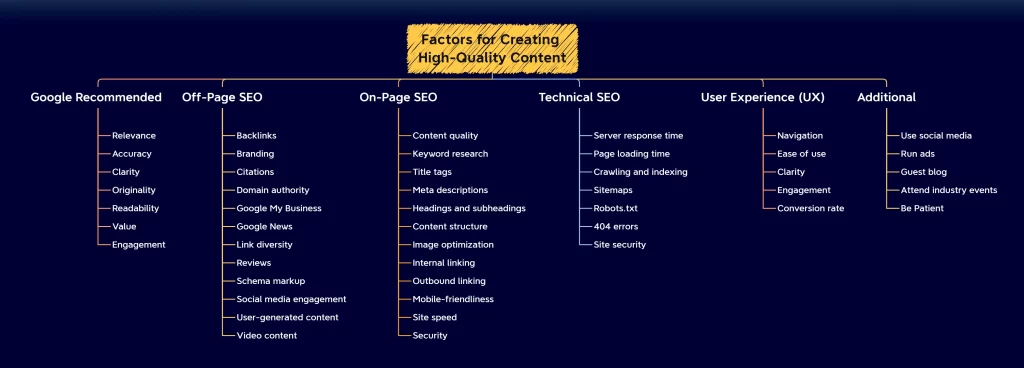In today’s digital age, content is king.
With so much information available at our fingertips, it’s more important than ever to create content that is high-quality and resonates with your audience.
If you can do this, you’ll be well on your way to building a successful online presence.
Creating high-quality content is essential to attract and retain readers and improve your website’s ranking.
Here are some factors that contribute to creating high-quality content:
Table of Contents
Google Recommended Factors for Content Ranking
Google’s E-E-A-T factors are a set of guidelines that help website owners create high-quality content that is relevant, accurate, and trustworthy. These factors are important for SEO because they help search engines determine the quality of your content. By creating content that meets Google’s E-E-A-T guidelines, you can improve your website’s ranking in search results.
The E-E-A-T factors are as follows:
- Experience: The author’s experience is an important factor to consider when evaluating the quality and trustworthiness of content.
- Expertise: This refers to the author’s or publisher’s level of knowledge and experience in the topic area.
- Authoritativeness: This refers to the author’s or publisher’s credibility and trustworthiness.
- Trustworthiness: This refers to the accuracy and reliability of the content.
Following are the factors to achieve the Google’s E- E-A-T factor :
Relevance
Relevance is the degree to which your content is relevant to the search query. Search engines want to show users the most relevant results, so it is important to make sure that your content is relevant to the keywords that users are searching for.
Accuracy
Accuracy is the degree to which your content is factually correct. Search engines want to show users accurate information, so it is important to make sure that your content is accurate.
Clarity
Clarity is the degree to which your content is easy to understand. Search engines want to show users content that is easy to understand, so it is important to make sure that your content is clear and concise.
Originality
Originality is the degree to which your content is new and unique. Search engines want to show users original content, so it is important to make sure that your content is not plagiarized.
Readability
Readability is the degree to which your content is easy to read. Search engines want to show users content that is easy to read, so it is important to make sure that your content is well-written and easy to scan.
Value
Value is the degree to which your content is useful and informative. Search engines want to show users content that is valuable, so it is important to make sure that your content is informative and helpful.
Engagement
Engagement is the degree to which users interact with your content. Search engines want to show users content that is engaging, so it is important to make sure that your content is interesting and informative.
These factors are important for SEO because they help search engines determine the quality of your content. By creating high-quality content that is relevant, accurate, clear, original, readable, valuable, and engaging, you can improve your website’s ranking in search results.
Google recommends that you focus on creating high-quality content that is relevant to your target audience. You should also make sure that your content is well-written and easy to read. Additionally, you should promote your content on social media and other online platforms. By following these tips, you can improve your website’s SEO and attract more visitors.

Followings are the best SEO industry practices for better SERP ranking:
On-page SEO
On-page SEO is the process of optimizing a website’s content, code, and structure so that it ranks higher in search engine results pages (SERPs). There are a number of factors that contribute to on-page SEO, including:
Content quality
The quality of your content is one of the most important ranking factors. Google wants to rank pages that provide users with high-quality, relevant information. This means that your content should be well-written, informative, and engaging.
Keyword research
When you’re creating content, it’s important to do your keyword research. This will help you to identify the keywords that people are searching for and that are relevant to your business.
Title tags
Title tags are the headlines that appear in search results. They are important for SEO because they help search engines understand the content of your pages and rank them accordingly. Title tags should be descriptive and accurate, and they should include your target keywords.
Meta descriptions
Meta descriptions are the short snippets of text that appear below the title tags in search results. They are not directly used by search engines to rank pages, but they can help users decide whether or not to click on your links. Meta descriptions should be informative and persuasive, and they should include your target keywords.
Headings and Subheadings
Headings and subheadings are used to break up your content and make it easier to scan. They are also important for SEO because they help search engines understand the structure of your pages. Headings and subheadings should be descriptive and use your target keywords.
Content Structure
The structure of your content is important for SEO because it helps search engines understand the flow of your content and how it relates to other pages on your website. Your content should be well-organized and easy to follow.
Image Optimization
Images can be a great way to add visual interest to your pages and improve user engagement. However, if you are not careful, they can also hurt your SEO. Make sure to optimize your images by adding alt text and titles that include your target keywords.
Internal Linking
Internal linking is the process of linking to other pages on your website from your own pages. It is important for SEO because it helps search engines crawl and index your pages. Internal linking also helps users navigate your website and find the information they are looking for.
Outbound Linking
Outbound linking is the process of linking to other websites from your own pages. It can be a great way to build relationships with other websites and improve your website’s authority. However, it is important to link to high-quality websites that are relevant to your content.
Mobile-Friendliness
More and more people are using their mobile devices to access the internet. It is important to make sure that your website is mobile-friendly so that users can easily access your content on their phones and tablets.
Site Speed
Site speed is another important factor for SEO. Search engines prefer to rank websites that load quickly. There are a number of things you can do to improve your website’s speed, such as optimizing your images, minifying your CSS and JavaScript, and using a content delivery network (CDN).
Security
Security is also an important factor for SEO. Search engines prefer to rank websites that are secure. Make sure that your website is using a secure connection (HTTPS) and that you have up-to-date security software.
Off-page SEO
Backlinks
Backlinks are links from other websites to yours. They’re a valuable ranking factor because they show Google that other websites trust yours.
Branding
Branding is the process of creating a unique identity for your business or product in the minds of your target audience. It involves developing a strong brand name, logo, and messaging that will resonate with your audience and make them more likely to choose your business over your competitors.
Citations
Citations are references to your website or business that appear on other websites. They can be in the form of links, mentions, or even just the name of your business. Citations can help to improve your website’s visibility in search engines and can also help to build trust with potential customers.
Domain Authority
Domain authority (DA) is a measure of how authoritative a website is in a particular niche. It is calculated by a number of factors, including the number and quality of backlinks pointing to the website, the age of the website, and the amount of traffic it receives. A higher DA can help your website to rank higher in search engines.
Google My Business
Google My Business (GMB) is a free service that allows businesses to create a listing on Google Maps and Google Search. GMB listings can include information such as your business name, address, phone number, hours of operation, and website. They can also include photos, reviews, and other information that can help potential customers to learn more about your business.
Google News
Google News is a news aggregator that collects news articles from a variety of sources. When your website is featured in Google News, it can help to increase its visibility and reach a wider audience.
Link diversity
Link diversity is the variety of websites that link to your website. Having a diverse link profile can help to improve your website’s authority and ranking in search engines.
Reviews
Reviews are a form of social proof that can help to build trust with potential customers. When potential customers see that your business has positive reviews, they are more likely to choose your business over your competitors.
Schema Markup
Schema markup is a type of code that you can add to your website to provide additional information about your content. This information can be used by search engines to better understand your content and to display it more prominently in search results.
Social Media Engagement
Social media engagement is the level of interaction that your business has with its followers on social media platforms. This interaction can include things like likes, comments, shares, and retweets. Social media engagement can help to improve your website’s visibility in search engines and can also help to build trust with potential customers.
User-Generated Content
User-generated content (UGC) is content that is created by users of your website or product. This content can include things like reviews, photos, videos, and blog posts. UGC can help to improve your website’s visibility in search engines and can also help to build trust with potential customers.
Video Content
Video content is a type of content that uses video to deliver information or entertainment. Video content can be a great way to engage your audience and to improve your website’s visibility in search engines.
Technical SEO
Server Response Time
Server response time is the time it takes for a web server to respond to a request from a web browser. This includes the time it takes to find the requested file, send it to the browser, and process any additional requests, such as images or scripts. A fast server response time is important for user experience, as a slow response time can lead to users abandoning a website before it has a chance to load.
Page Loading Time
Page loading time is the total time it takes for a web page to load, including the server response time, the time it takes for the browser to render the page, and the time it takes for any additional resources, such as images or scripts, to load. A fast page loading time is also important for user experience, as a slow loading time can lead to users abandoning a website before it has a chance to load.
Crawling and Indexing
Crawling and indexing are the two main processes that search engines use to find and index web pages. Crawling is the process of following links from one page to another, while indexing is the process of storing information about each page, such as the title, content, and keywords. A well-crawled and indexed website is more likely to be found by search engines and appear in search results.
Sitemaps
Sitemaps are files that tell search engines about the pages on your website. They can be used to help search engines crawl and index your website more effectively. There are two types of sitemaps: XML sitemaps and HTML sitemaps. XML sitemaps are more commonly used, as they provide more information to search engines.
Robots.txt
Robots.txt is a file that tells search engines which pages on your website they should crawl and index. It can be used to prevent search engines from crawling certain pages, such as pages that are under construction or that contain sensitive information.
404 errors
404 errors are errors that occur when a web browser cannot find the requested page. They can be caused by a variety of factors, such as a typo in the URL or a deleted page. 404 errors can be frustrating for users, so it is important to fix them as soon as possible.
Site Security
Site security is important for protecting your website from unauthorized access and malicious attacks. There are a number of things you can do to improve your site security, such as using strong passwords, installing security software, and keeping your software up to date.
User experience (UX)
Navigation
Navigation is the way that users move around a website or app. It is important to make sure that navigation is clear and easy to use, so that users can find what they are looking for quickly and easily. There are a number of different ways to create effective navigation, such as using menus, breadcrumbs, and search bars.
Ease of use
Ease of use is the degree to which a website or app is easy to use. It is important to make sure that your website or app is easy to navigate, understand, and interact with. There are a number of different factors that contribute to ease of use, such as the use of clear and concise language, the use of familiar design patterns, and the provision of helpful feedback.
Clarity
Clarity is the degree to which a website or app is easy to understand. It is important to make sure that your website or app is well-organized and easy to scan. There are a number of different factors that contribute to clarity, such as the use of clear headings and subheadings, the use of white space, and the use of consistent design elements.
Engagement
Engagement is the degree to which users are interested in and involved with a website or app. It is important to make sure that your website or app is engaging, so that users will want to stay and interact with it. There are a number of different ways to create engagement, such as using interesting content, providing opportunities for interaction, and creating a sense of community.
Conversion Rate
Conversion rate is the percentage of visitors to a website or app who take a desired action, such as making a purchase, signing up for a newsletter, or completing a survey. It is important to track your conversion rate and make improvements to your website or app to increase it. There are a number of different factors that can affect conversion rate, such as the clarity of your call to action, the design of your website or app, and the quality of your content.
How UX Affects SEO
UX, or user experience, is the overall experience that a user has when interacting with a website or app. It includes factors such as the ease of use, clarity, and engagement of the website or app. UX can have a significant impact on SEO, or search engine optimization.
Here are some of the ways that UX can affect SEO:
- Higher bounce rates: If users find your website or app difficult to use or understand, they are more likely to bounce back to the search results page. This can lead to lower rankings in search results.
- Less time spent on page: If users don’t spend much time on your website or app, it signals to search engines that your content is not relevant or engaging. This can also lead to lower rankings.
- Fewer backlinks: If users don’t share or link to your website or app, it signals to search engines that your content is not valuable. This can also lead to lower rankings.
How to improve UX for SEO
There are a number of things you can do to improve UX for SEO, including:
- Make your website or app easy to use: Use clear and concise language, familiar design patterns, and helpful feedback.
- Organize your content in a logical way: Use clear headings and subheadings, and use white space to make your content easy to scan.
- Use engaging content: Use interesting images, videos, and infographics to capture users’ attention.
- Provide opportunities for interaction: Allow users to comment, share, and ask questions.
- Create a sense of community: Encourage users to connect with each other on social media or in forums.
Additional tips
Use social media
Social media is a great way to connect with potential customers and build relationships with other businesses. It can also be a great way to drive traffic to your website and improve your SEO.
There are a number of things you can do to use social media for SEO, such as:
- Share your content on social media: Share your blog posts, articles, and other content on social media. This will help to get your content in front of more people and drive traffic to your website.
- Use relevant hashtags: When you share your content on social media, use relevant hashtags so that people can find it.
- Run social media ads: You can also run social media ads to target specific audiences and drive traffic to your website.
Run Ads
Paid advertising can be a great way to get your website in front of more people and improve your SEO. There are a number of different paid advertising platforms that you can use, such as Google AdWords, Facebook Ads, and Twitter Ads.
When you run paid ads, you are essentially bidding on keywords that you want your ad to show up for. When someone searches for one of your keywords, your ad may appear in the search results.
Paid advertising can be a great way to get your website in front of more people, but it is important to track your results so that you can see what is working and what is not.
Guest Blog
Guest blogging is a great way to get your content in front of a new audience and improve your SEO. When you guest blog, you write an article for another website that is relevant to your niche. In the article, you should include a link back to your website.
Guest blogging can be a great way to build relationships with other bloggers and improve your website’s authority.
Attend Industry Events
Attending industry events is a great way to network with other businesses in your niche and learn about the latest trends. It can also be a great way to get your website in front of more people and improve your SEO.
When you attend industry events, be sure to bring business cards and wear a name tag. You should also make an effort to introduce yourself to other attendees and learn about their businesses.
Be Patient
SEO is a long-term game. It takes time to build up your website’s authority and rank for high-traffic keywords. Don’t expect to see results overnight.
Be patient and keep working on your website’s SEO. Over time, you will see your website’s rankings improve.
By focusing on these factors, you can create high-quality content that resonates with your target audience and helps improve your website’s ranking.
Conlcusion
In conclusion, there are a number of key factors to consider when creating high-quality content that resonates with your audience. These factors include relevance, accuracy, clarity, engagement, originality, value, and consistency. By following these factors, you can create content that is informative, engaging, and helpful to your audience.
In addition to the factors mentioned above, it is also important to keep your audience in mind when creating content. What are their interests? What are their needs? What are they looking for? By understanding your audience, you can create content that is more likely to resonate with them.
Finally, it is important to be consistent with your content creation efforts. If you only publish content sporadically, it will be difficult to build an audience. By publishing high-quality content on a regular basis, you can attract and retain an audience of loyal readers.
- Leonardo AI: Secrets of Powerful AI art Studio - May 20, 2023
- Google Bard Features :Easily Available to Everyone - May 12, 2023
- Google Bard vs ChatGPT: No. 1 The Ultimate Guide - May 7, 2023






